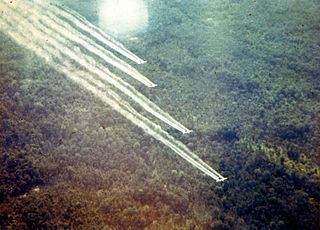
Agent Orange is a herbicide and defoliant chemical, one of the "tactical use" Rainbow Herbicides. It is widely known for its use by the U.S. military as part of its herbicidal warfare program, Operation Ranch Hand, during the Vietnam War from 1961 to 1971. It is a mixture of equal parts of two herbicides, 2,4,5-T and 2,4-D. In addition to its damaging environmental effects, traces of dioxin found in the mixture have caused major health problems for many individuals who were exposed.

Herbicides, also commonly known as weedkillers, are substances used to control unwanted plants. Selective herbicides control specific weed species, while leaving the desired crop relatively unharmed, while non-selective herbicides can be used to clear waste ground, industrial and construction sites, railways and railway embankments as they kill all plant material with which they come into contact. Apart from selective/non-selective, other important distinctions include persistence, means of uptake, and mechanism of action. Historically, products such as common salt and other metal salts were used as herbicides, however these have gradually fallen out of favor and in some countries a number of these are banned due to their persistence in soil, and toxicity and groundwater contamination concerns. Herbicides have also been used in warfare and conflict.

Weed control is the botanical component of pest control, which attempts to stop weeds, especially noxious weeds, from competing with desired flora and fauna including domesticated plants and livestock, and in natural settings preventing non native species competing with native species.

Operation Ranch Hand was a U.S. military operation during the Vietnam War, lasting from 1962 until 1971. Largely inspired by the British use of 2,4,5-T and 2,4-D during the Malayan Emergency in the 1950s, it was part of the overall chemical warfare program during the war called "Operation Trail Dust". Ranch Hand involved spraying an estimated 20 million U.S. gallons (76,000 m3) of defoliants and herbicides over rural areas of South Vietnam in an attempt to deprive the Viet Cong of food and vegetation cover. Areas of Laos and Cambodia were also sprayed to a lesser extent. Nearly 20,000 sorties were flown between 1961 and 1971.

Clopyralid is a selective herbicide used for control of broadleaf weeds, especially thistles and clovers. Clopyralid is in the picolinic acid family of herbicides, which also includes aminopyralid, picloram, triclopyr, and several less common herbicides. For control of creeping thistle, Cirsium arvense, a noxious, perennial weed, clopyralid is one of the few effective herbicides available. It is particularly damaging to peas, tomatoes and sunflowers and can render potatoes, lettuce and spinach inedible. It does not affect grasses of the family Poaceae.

Glyphosate is a broad-spectrum systemic herbicide and crop desiccant. It is an organophosphorus compound, specifically a phosphonate, which acts by inhibiting the plant enzyme 5-enolpyruvylshikimate-3-phosphate synthase. It is used to kill weeds, especially annual broadleaf weeds and grasses that compete with crops. It was discovered to be an herbicide by Monsanto chemist John E. Franz in 1970. Monsanto brought it to market for agricultural use in 1974 under the trade name Roundup. Monsanto's last commercially relevant United States patent expired in 2000.

Paraquat (trivial name; ), or N,N′-dimethyl-4,4′-bipyridinium dichloride (systematic name), also known as Methyl Viologen, is an organic compound with the chemical formula [(C6H7N)2]Cl2. It is classified as a viologen, a family of redox-active heterocycles of similar structure. Paraquat was manufactured by Chevron. This salt is one of the most widely used herbicides. It is quick-acting and non-selective, killing green plant tissue on contact. It is also toxic to human beings and animals due to its redox activity, which produces superoxide anions. It has been linked to the development of Parkinson's disease and is banned in several countries.

Sodium chlorate is an inorganic compound with the chemical formula NaClO3. It is a white crystalline powder that is readily soluble in water. It is hygroscopic. It decomposes above 300 °C to release oxygen and leaves sodium chloride. Several hundred million tons are produced annually, mainly for applications in bleaching pulp to produce high brightness paper.

Alachlor is an herbicide from the chloroacetanilide family. It is an odorless, white solid. The greatest use of alachlor is for control of annual grasses and broadleaf weeds in crops. Use of alachlor is illegal in the European Union and no products containing alachlor are currently registered in the United States.

Diquat is the ISO common name for an organic dication that, as a salt with counterions such as bromide or chloride is used as a contact herbicide that produces desiccation and defoliation. Diquat is no longer approved for use in the European Union, although its registration in many other countries including the USA is still valid.

Phenoxy herbicides are two families of chemicals that have been developed as commercially important herbicides, widely used in agriculture. They share the part structure of phenoxyacetic acid.

Glufosinate is a naturally occurring broad-spectrum herbicide produced by several species of Streptomyces soil bacteria. Glufosinate is a non-selective, contact herbicide, with some systemic action. Plants may also metabolize bialaphos, another naturally occurring herbicide, directly into glufosinate. The compound irreversibly inhibits glutamine synthetase, an enzyme necessary for the production of glutamine and for ammonia detoxification, giving it antibacterial, antifungal and herbicidal properties. Application of glufosinate to plants leads to reduced glutamine and elevated ammonia levels in tissues, halting photosynthesis and resulting in plant death.

The Rainbow Herbicides are a group of "tactical use" chemicals used by the United States military in Southeast Asia during the Vietnam War. Success with Project AGILE field tests with herbicides in South Vietnam in 1961 and inspiration by the British use of herbicides and defoliants during the Malayan Emergency in the 1950s led to the formal herbicidal program Trail Dust. Herbicidal warfare is the use of substances primarily designed to destroy the plant-based ecosystem of an agricultural food production and/or to destroy foliage which provides the enemy cover.

Simazine is a herbicide of the triazine class. The compound is used to control broad-leaved weeds and annual grasses.

Dichlorprop is a chlorophenoxy herbicide similar in structure to 2,4-D that is used to kill annual and perennial broadleaf weeds. It is a component of many common weedkillers. About 4 million pounds of dichlorprop are used annually in the United States.
This is an index of articles relating to pesticides.

2,4-Dichlorophenoxyacetic acid is an organic compound with the chemical formula C8H6Cl2O3 which is usually referred to by its ISO common name 2,4-D. It is a systemic herbicide which selectively kills most broadleaf weeds by causing uncontrolled growth in them but most grasses such as cereals, lawn turf, and grassland are relatively unaffected.

Aminocyclopyrachlor is a selective, low-toxicity herbicide that provides pre- and post-emergent control of broadleaf weeds, woody species, vines and grasses on several non-food use sites, such as rights of way, wildlife management areas, recreational areas, turf/lawns, golf courses and sod farms. It was conditionally registered as Imprelis by DuPont in August 2010, and first used in Fall 2010. The chemical is a systemic herbicide and acts by disrupting gene expression. This causes undifferentiated cell division and elongation.

Cyanazine is a herbicide that belongs to the group of triazines. Cyanazine inhibits photosynthesis and is therefore used as a herbicide.


















